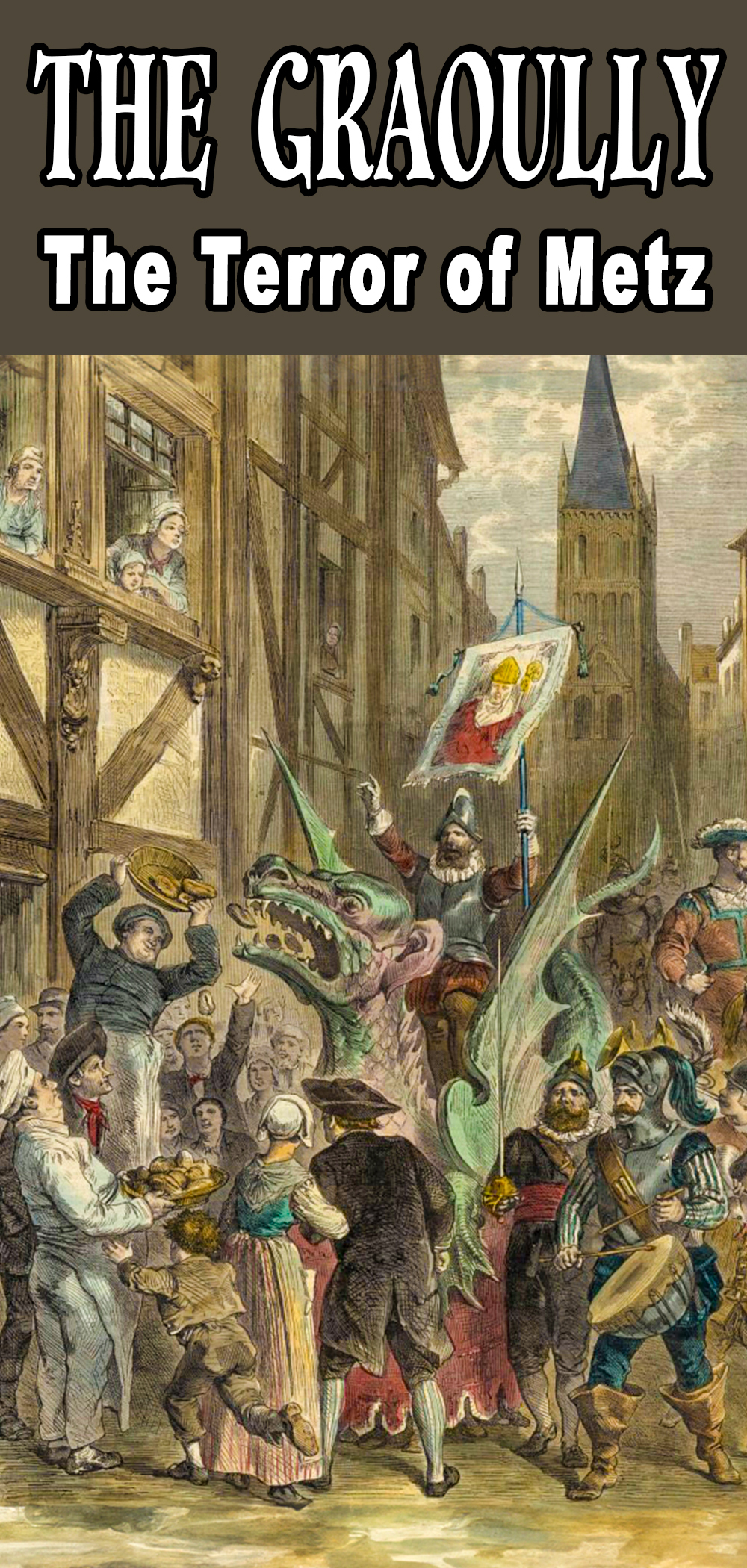At the mention of its name, the inhabitants of Metz would flee inside their homes. The Graoully was a powerful, ugly, nasty monster that raged in and around Lorraine.
That was a long time ago, during Roman times. Since then, legend has taken precedence over history, which explains why there are so many versions of the beast's deeds (and misdeeds).
And, of course, we mustn't forget the hero of the day, Saint Clement, who saved the people of Metz from their dragon.
The monster is known by several names: Graouli, Graouilly, Graouilli, Grully or Graully, but it's the name Graoully that has won unanimous approval!
So if you visit Metz, there's no doubt that you'll come across traces evoking the memory of the dragon - and a few, albeit fewer, about Saint Clément. Ready for a visit?
The legend of the Graoully and Saint Clément
The legend goes that in the 3rd century, during the time when Metz was part of the Roman Empire, a terrifying creature took up residence in the ruins of the amphitheatre, just outside the city.
It was called the Graoully, a rather barbaric name derived from the German "graulich," which roughly means "macabre, horrible, monstrous." And believe me, it was scarier than Maleficent and Cruella combined.
![Procession du Graoully [Public Domain via Wikimedia Commons] Procession du Graoully [Public Domain via Wikimedia Commons]](https://frenchmoments.eu/wp-content/uploads/2023/09/Procession-du-Graoully-Public-Domain-via-Wikemedia-Commons-scaled-1.jpg)
Procession of the Graoully in Metz [Public Domain via Wikimedia Commons]
What did the monster look like?
The Graoully, well, it wasn't your everyday house cat, that's for sure!
It had a silhouette that strongly resembled that of a crocodile straight out of Cleopatra's dungeons.
Its mouth was a veritable arsenal of teeth, as if someone had decided to equip its jaw with cutting-edge circular saws.
Its eyes, oh, its eyes, they looked like two blazing embers that hadn't received an invitation to Aunt Josephine's birthday party.
And its tongue, a razor-sharp tip that could have rivaled the flame of a very active forge.
Want to know about its breath? It was as if someone had tried to barbecue with a sulphur recipe, a surefire explosive dish!
As for its gait, the Graoully, with its short legs and claws that would have scared Wolverine, wasn't exactly the fastest in the gang.
Its tail, on the other hand, dragged on the ground, writhing like a snake in the midst of a yoga session.
And rough scales, it had them everywhere, as if someone thought that the latest fashion trend was to be as resilient as a knight's armor.
To complete the description of this creature, it had two enormous bat-like wings sprouting from its back.
The abominable monster of Metz
Despite its menacing appearance and impressive size, the Graoully loved to take flight in Metz's sky, tracing large circles that would make you think geometry is truly terrifying.
But there was one thing that terrified our friend Graoully more than anything else: water. It stayed far, far away from the rivers of the Moselle and the Seille. For him, it was crystal clear: "No water, no trouble."
The Graoully was the stuff of nightmares for all the residents of Metz and the surrounding areas.
If you're looking for the definition of a nightmare, it was right there, feasting on human flesh as if it were just small appetizers. Every day, it was the same old story: an unfortunate victim vanished without a trace.
That wasn't all; the Roman amphitheatre was its headquarters, and it had a jolly gang of reptilian pals to keep it company.
Fear in the countryside and fear in the city!
In the countryside, the farmers were as rare as an orange tree on Irish soil, and their cows had turned their stables into bunkers.
In the city, it was a major freak-out: the streets were as lively as a cemetery at midnight.
When hunger gnawed at its stomach (which was often the case), the Graoully embarked on an aerial acrobatics show worthy of the best circus performers.
It flew so low that it felt like it was brushing against the rooftops, desperately seeking its next victim to add to the menu.
You can bet that the residents of Metz took precautions to avoid looking like a walking snack.
Resistance is futile
The soldiers were there, armed to the teeth, but their arrows bounced off the monster like rubber bullets. And their javelins shattered faster than a politician's campaign promises.
At its mere appearance, the residents went into hermit mode, barricading themselves in their houses as if it were the Black Friday of dragons.
Here comes Clement!
But you see, in life, there's always one or two heroes who show up when things get dicey. And in this case, it was a nobleman by the name of Clement, but not just any Clement, no, it was "Saint" Clement. Sent by Saint Peter, he had arrived in Metz from Rome with a missionary bag on his back and a desire to preach the gospel in his pocket.
Saint Clement wasn't the type to give speeches within the four walls of his room. No, he liked to do it old-school, right on the public squares, just to spice things up in the city. And the people hung on to his words like teenagers on TikTok.
The Challenge is set
Well, it could have ended there, but then an old legionnaire, probably a retiree craving some action, challenged him: "If you can perform miracles, then get rid of this Graoully!"
Saint Clement was well aware of the dragon's misdeeds, but he wasn't the type to back down from a challenge.
The next morning, he showed up near the amphitheatre where the Graoully was squatting like "I'm the king of the block."
And he was all alone, our saint, without guns, without a shield, politely refusing the help of a few soldiers who wanted to flex their muscles.
The people, on the other hand, were there at a respectable distance, with eyes as wide as saucers. Saint Clement advanced without showing the slightest fear. Not a hint of cold sweat, just pure confidence!
![Graoully by Auguste Migette [Public Domain via Wikimedia Commons] La capture du Graoully par saint Clément. Auguste Migette [Public Domain via Wikimedia Commons]](https://frenchmoments.eu/wp-content/uploads/2023/09/Graoully-by-Auguste-Migette-Public-Domain-via-Wikimedia-Commons.jpg)
The capture of the Graoully by Saint Clement. Auguste Migette [Public Domain via Wikimedia Commons]
Clement strikes back
And then, in a surprise party mode, the Graoully emerged from behind an arch, ready to pounce like a tiger on its prey.
Saint Clement? The guy was cool as a cucumber. He locked eyes with it and did something crazy: he reached out his hand!
The Graoully, well, it was there, all hesitant, like a kid caught red-handed stealing candy at the store.
Then, Saint Clement removed the stole he was wearing (yes, he had style even in his clothes) and threw it around the monster's neck. The stole clung to the scales like a cat to a curtain of pearls and wrapped around the monster's neck.
And then came the moment of the masterful knot. Saint Clement tightened it firmly, and the Graoully found itself trussed up like a discounted sausage.
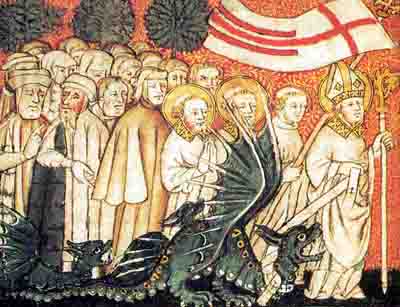
St Clement destroying the Graoully at Metz
The holy man drags the dragon to the edge of the Seille, and whoosh, into the deep water!
The Graoully must have had the biggest bath of its life, and it disappeared in a whirlwind worthy of an episode of "Ninja Warrior." And that's how Metz bid farewell to its mascot dragon, forever.
It's Party Time in the City!
Back in town, Saint Clément received a rock star welcome.
The people of Metz threw him a triumph, like a victory parade, complete with confetti and all the works.
The city was so impressed that it decided to go all-in on Christianity. It marked the beginning of an era of prosperity, as if Metz had received a stroke of luck.
As a token of gratitude, every year, the people of Metz decide to throw a big party.
They organise a procession that goes through the city streets, and guess what they proudly carry? Saint Clement ?
Nope, the image of the Graoully!
![Graoully [Public Domain via Wikimedia Commons] Procession du Graoully [Public Domain via Wikimedia Commons]](https://frenchmoments.eu/wp-content/uploads/2023/09/Graoully-Public-Domain-via-Wikimedia-Commons.jpg)
Procession of the Graoully [Public Domain via Wikimedia Commons]
But beware, it's not in terror, it's in joy and good spirits. It almost looks like a carnival parade, but with fewer people-eating dragons.
So, even monsters can end up in the spotlight, once they're on the right track of history. Go figure!
Did the Graoullly really exist?
But beyond the legend, did the Graoully really exist?
Firstly, it is interesting to note that the story of the dragon of Metz is common in Europe. Similar legends can be found in :
- Fontaine-de-Vaucluse (the Coulobre),
- Poitiers (the Grand'Goule),
- Rouen (the Gargouille),
- Tarascon (the Tarasque),
- Furth im Wald in Germany (the Drachenstich)
Could this "dragon" be a kind of dinosaur that miraculously remained alive at the beginning of our era? Or a legendary spin-off of Michel and Georges' battles with the dragon? Perhaps it was a crocodile? A giant snake? A Lorraine Loch Ness 😉
Or did it symbolise the sin and paganism that reigned in the region at the time of Saint Clement (3rd century AD)?
The fertile minds of dreamers will lead us to tales in which legend merges with reality.
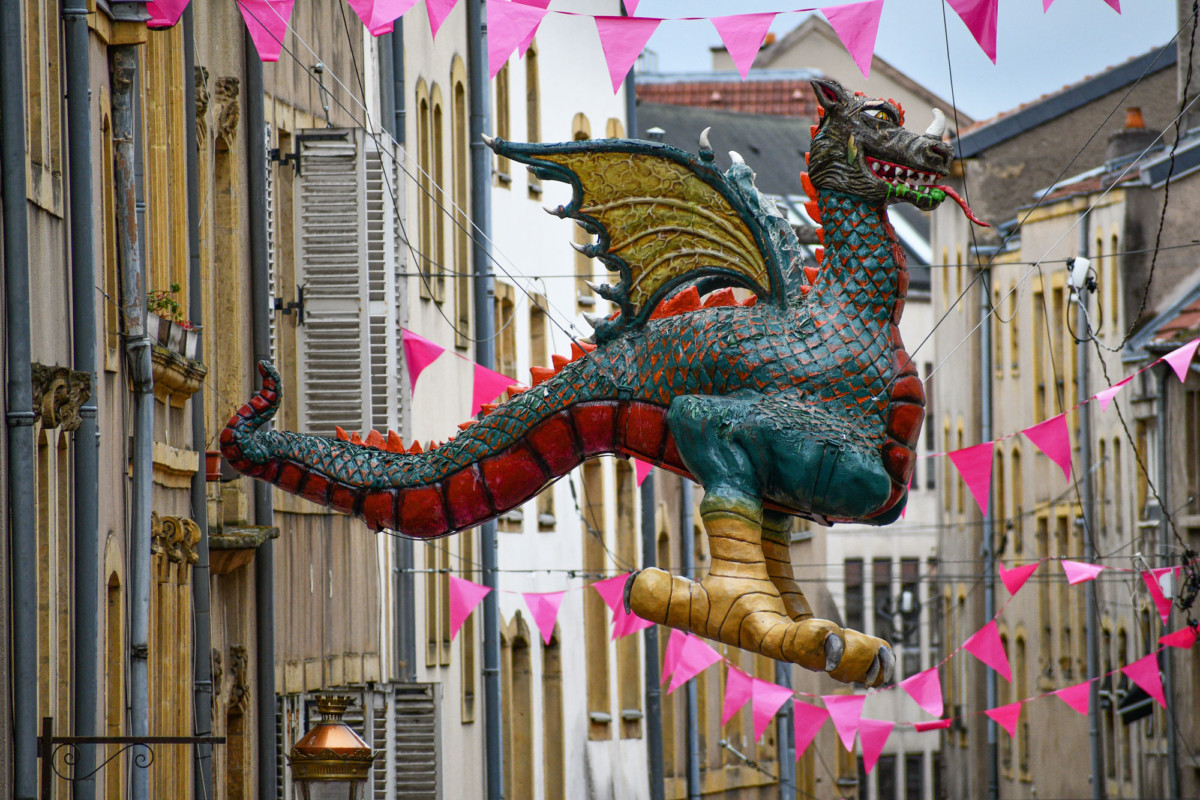
Rue Taison and the Graoully of Metz © French Moments
The Graoully: today's Big Brother?
The caption you read earlier in the article, I wrote with the assistance of artificial intelligence (AI). However, I've reworked the story several times... because AI is helpful, but fortunately, humans (still) have to take a second look! 🤔
On that subject, I asked him to suggest thoughts on what the Graoully would look like these days. And I found his answer so interesting that I can't resist sharing it with you (I've edited nothing of what follows below - it's the AI's answer verbatim): 😳
Introduction
In the current context, the Graoully could be seen as a visual representation of our concerns regarding privacy and ubiquitous surveillance. Just like Big Brother in George Orwell's novel '1984,' the Graoully would be a tangible embodiment of the institutions or entities that watch and control our lives, often without our knowledge.
1. Surveillance Cameras
The Graoully could be described as a creature with multiple eyes, symbolising surveillance cameras found in our streets, buildings, phones, and computers. These watchful eyes remind us that our every move is being observed.
2. Mass Data Collection
Just as the Graoully devoured human flesh, companies and governments "devour" our personal data. The Graoully could be a metaphor for how our personal information is collected, stored, and used without informed consent.
3. Loss of Privacy
Similar to how the people of Metz hid in their homes when the Graoully appeared, individuals today may feel compelled to limit their activities to preserve their privacy. The Graoully could symbolise how surveillance can restrict our freedom and spontaneity.
4. Ethical Questions
Just as the Graoully legend raised ethical questions about how to defeat it, contemporary surveillance raises debates about the balance between security and privacy, as well as the limits to be imposed on government and corporate surveillance.
5. Resistance
Like Saint Clément defied the Graoully, privacy and online freedom advocates fight against excessive surveillance. The Graoully could symbolise the need to remain vigilant and protect our fundamental rights in an era of growing surveillance.
Conclusion
En utilisant le Graoully comme une métaphore pour la surveillance contemporaine, on peut susciter des réflexions profondes sur les enjeux de la vie privée, de la sécurité et de la liberté individuelle dans notre société connectée.
Hmmm... this modern-day Graoully business is worth thinking about. 🤔
If this inspires you to post a comment, I invite you to do so at the very bottom of the article! I'd be interested to hear your thoughts on this modern-day Graoully.
Where to find the Graoully in Metz?
The memory of the Graoully has remained firmly anchored in the collective memory.
So much so that its image has become an asset in the tourist and/or commercial promotion of Metz (as we'll see later in the article).
This fascinating monster can be found in many parts of the city... so it's up to you to go and see it!
The monster in the Cathedral
The monster is depicted in high relief at the entrance to the Metz Cathedral on the neo-Gothic portal designed by architect Tormow in the 19th century.

The Graoully - Cathédrale de Metz © French Moments
We see him again chained at the feet of Saint Clement.
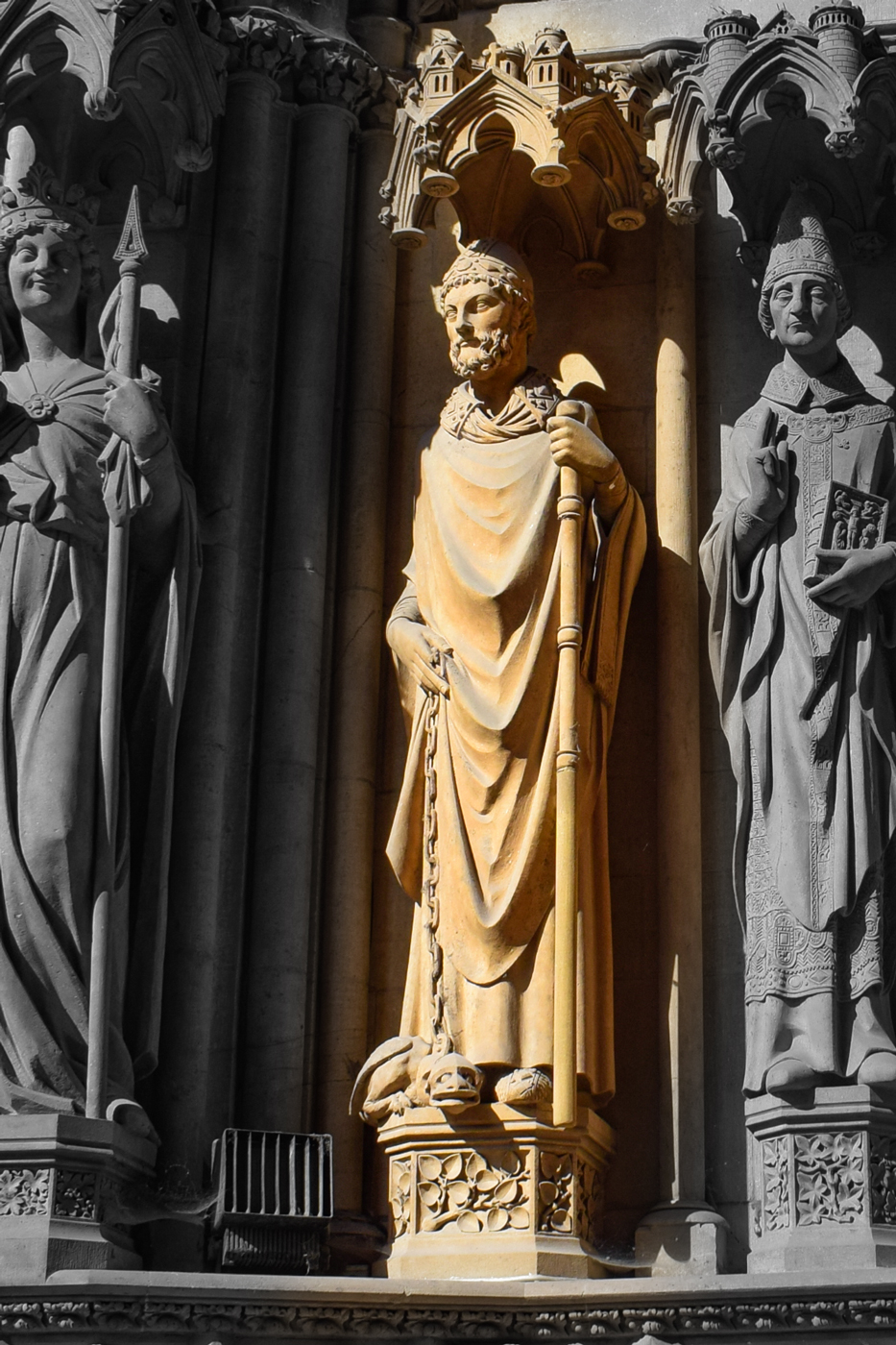
Saint-Clément - Cathédrale de Metz © French Moments
Higher up is another scene showing Saint Clement baptising a member of the faithful as Christ and the defeated Graoully look on.
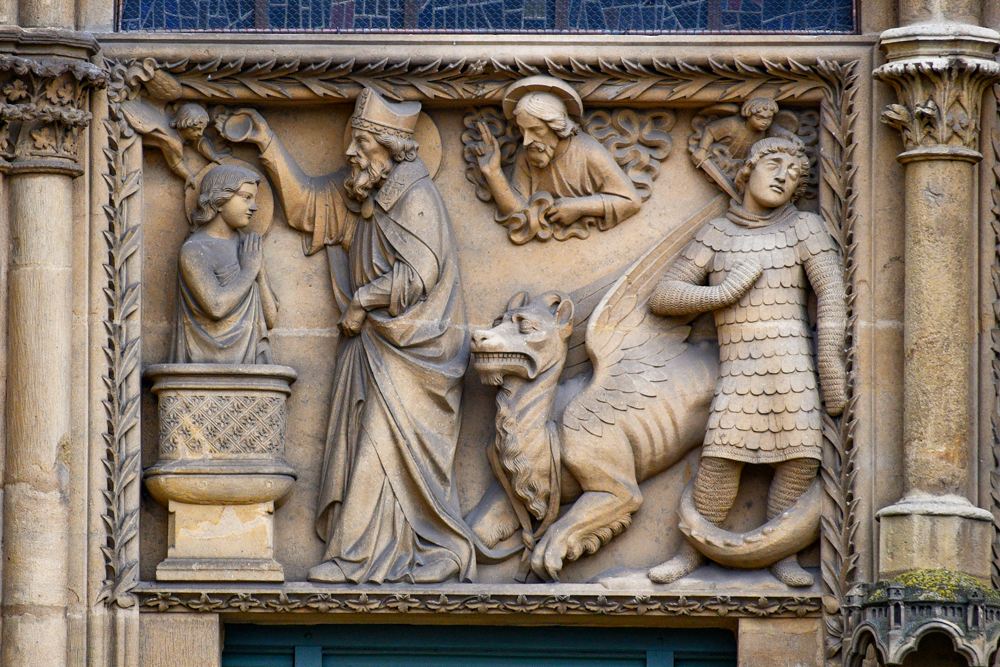
Saint Clément - Cathédrale de Metz © French Moments
In the cathedral, you can see a stained glass window depicting Saint Clement striking down the monster.
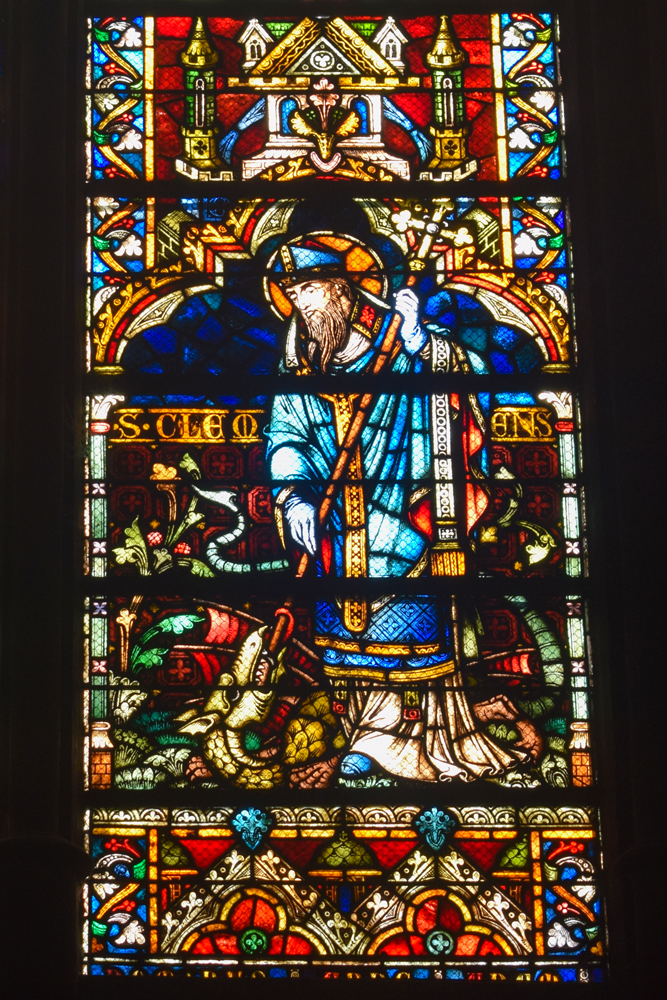
Stained glass window depicting Saint Clément - Metz Cathedral © French Moments
The effigy of the Graoully, currently on display in the crypt of Metz's Saint-Etienne cathedral, was used to frighten the locals during processions.
A similar effigy can be found in the Lorraine room at Haut-Kœnigsbourg castle in Alsace.

The Graoully hanging from the ceiling of the Lorraine room at Haut-Kœnigsbourg © French Moments
The monster in town
The Cour d'Or museum in Metz houses a 16th-century statue from Gorze. It is made of Jaumont stone with traces of polychromy. It depicts Saint Clement holding the dragon with his stole in his right hand. It is highly likely that the saint was holding the episcopal crosier in his left hand.

Statue of Saint Clément - musée de la Cour d'Or, Metz © French Moments
The oldest sculpture of the monster is located at 10 rue Chèvremont, on the so-called snake's house (maison du serpent).
As for the Rue Taison near Metz cathedral, its name is thought to be linked to the fear that gripped the inhabitants when the Graoully flew over the roofs in search of prey. People would say:
"Taisons, taisons-nous, voilà le Graoully qui passe.”
("Let's be quiet, let's be quiet, here comes the Graoully.")

The Graoully in Rue Taison © French Moments
Urban legend has it that the green roof of Metz station, built on the site of the ancient Roman amphitheatre where the Graoully once resided, is made from the monster's scales.

Gare de Metz © French Moments
Look closely at the long façade of the station to discover two effigies of the monster:

Graoully, Pavillon impérial, gare de Metz © French Moments

The Graoully © French Moments
The monster in the coat of arms
The Graoully has been used on a number of coats of arms, including those of the former commune of Le Sablon (now part of Metz), Metz Football Club (from 1967 to 2021), Metz Moselle Rugby Club and Metz Hockey Club.
In the Sablon district of Metz, there is a street named after the monster (Rue du Graoully) and a primary school, école primaire du Graoully.
Learn more about Metz and the Graoully
To read other versions of the legend of the Graoully de Metz, visit the following websites:
- Tout Metz
- The monstre and its legend on Wikipedia
- The legends of Metz on the tourist board's site (in French)
Discover on the blog:
- The other terror of Lorraine : Père Fouettard
- Discover Metz Cathedral
- Explore the city of Metz
- On our French blog Mon Grand-Est: 7 Raisons qui vous donneront envie de visiter Metz
My hotel recommendation in Metz
Would you like to stay in Metz and follow in the footsteps of the Graoully and Saint Clément? If so, I recommend the Hôtel de la Cathédrale*** in the old part of Metz. This hotel (where I stayed for a few nights) is ideally located opposite the cathedral, allowing you to explore the old town at your leisure!
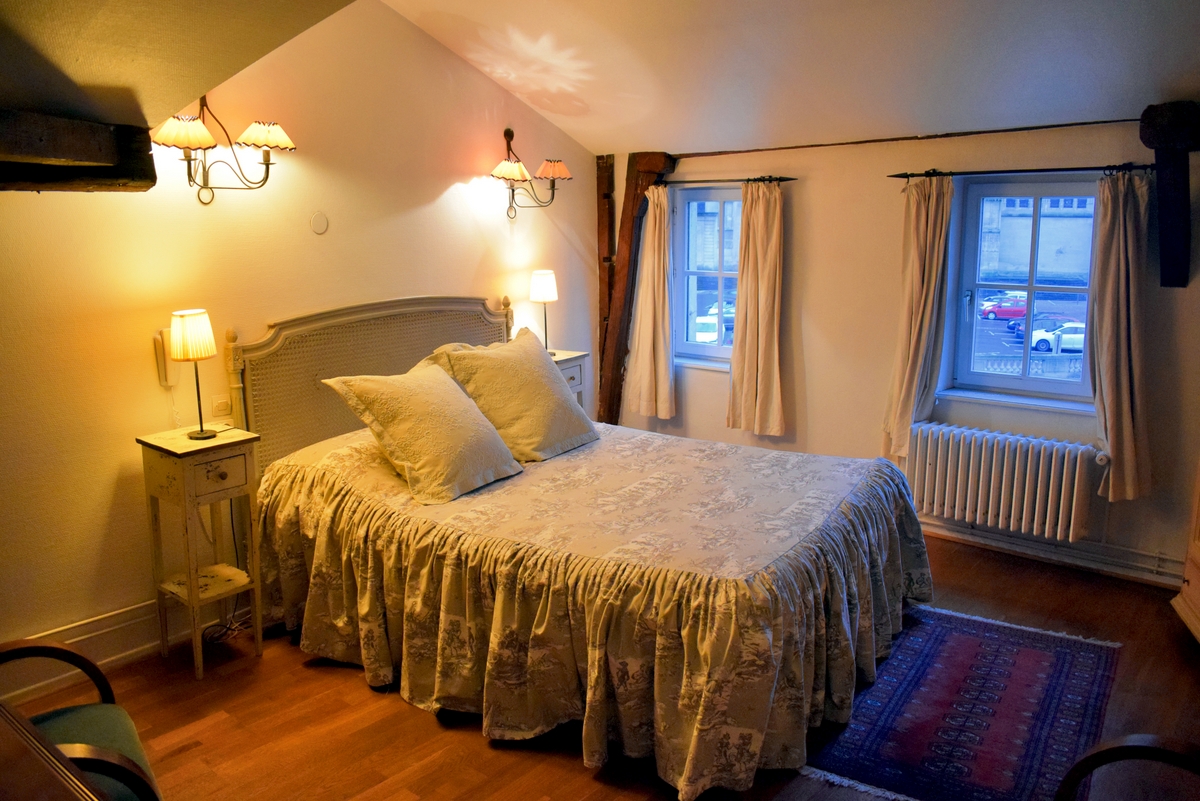
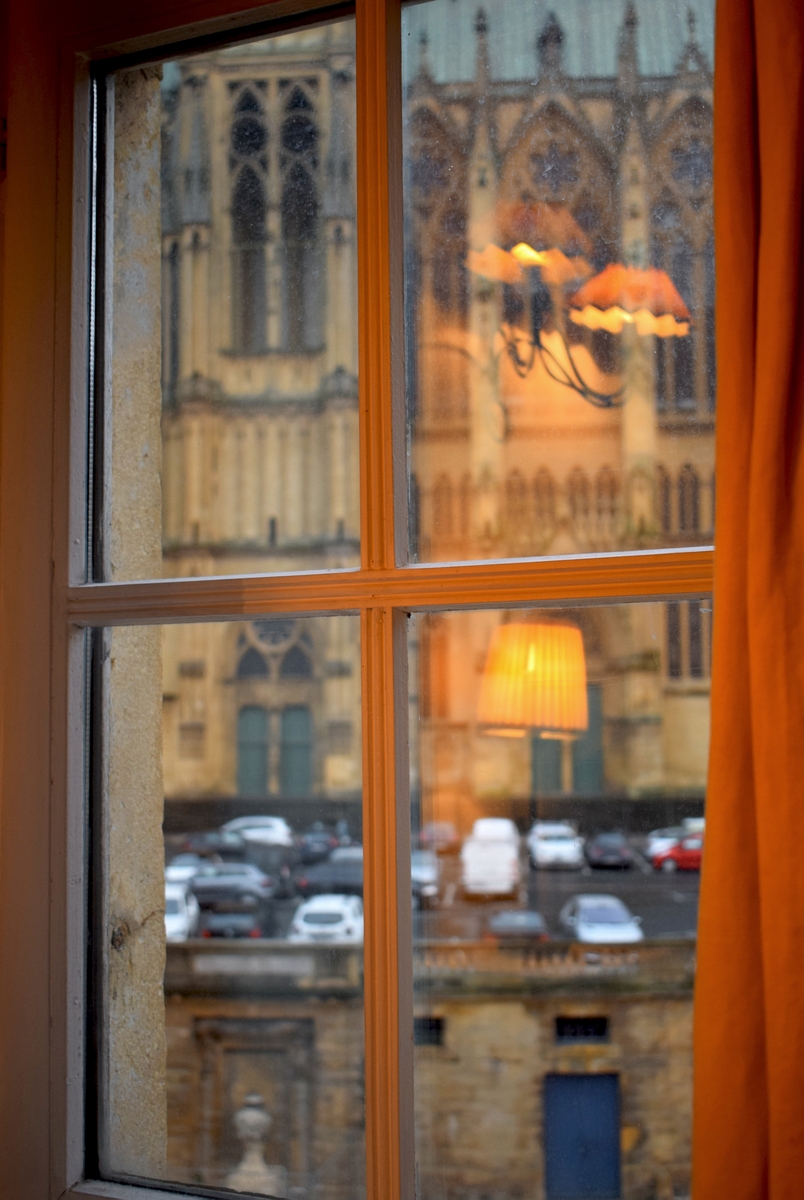
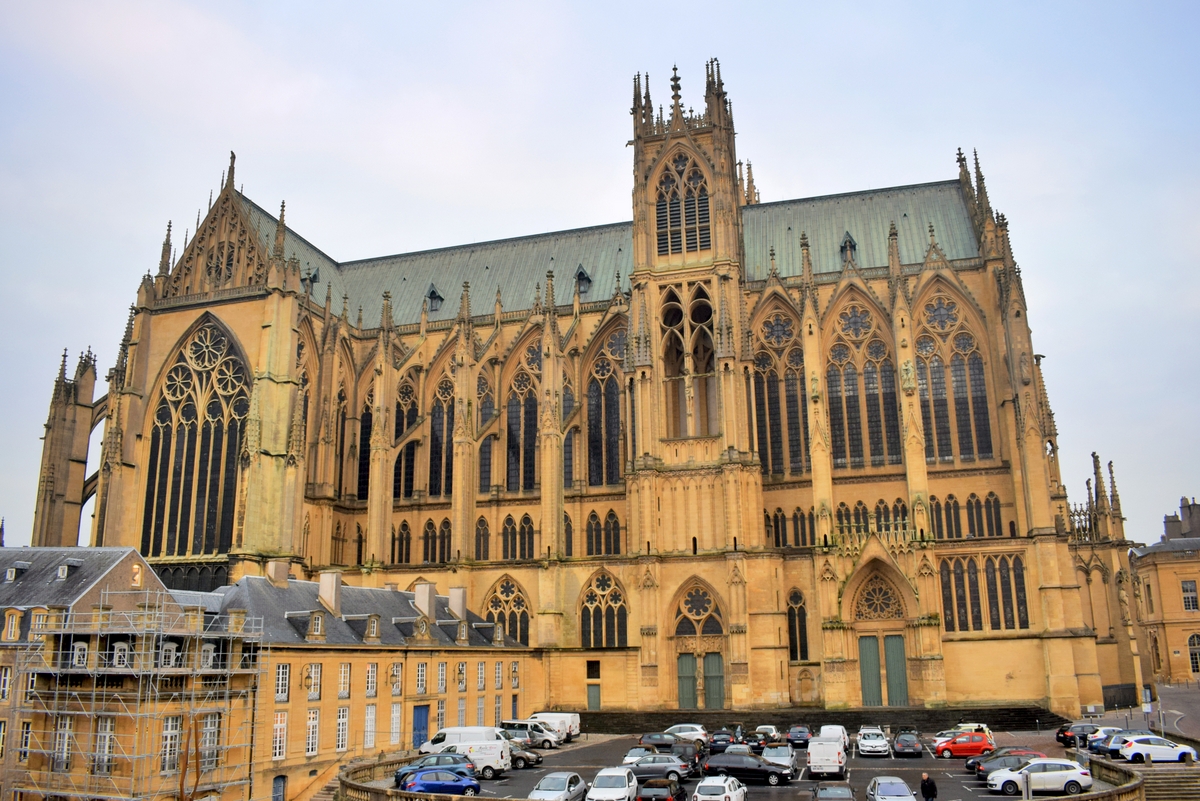
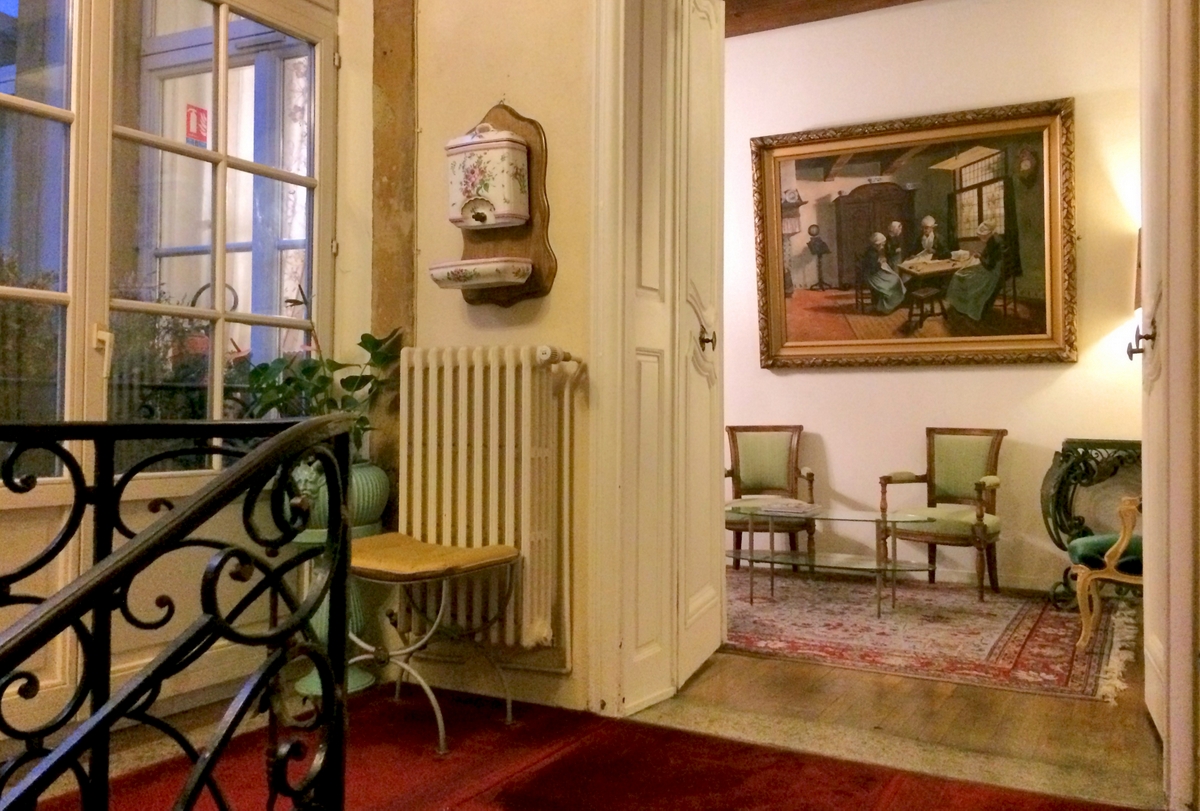
To find out more and book your room, click on this link.
If you would like a list of other hotels in Metz, browse the map below:
Pin on Pinterest
Did you enjoy this article? Share it on Facebook, X (Twitter) or pin the following image on Pinterest:
